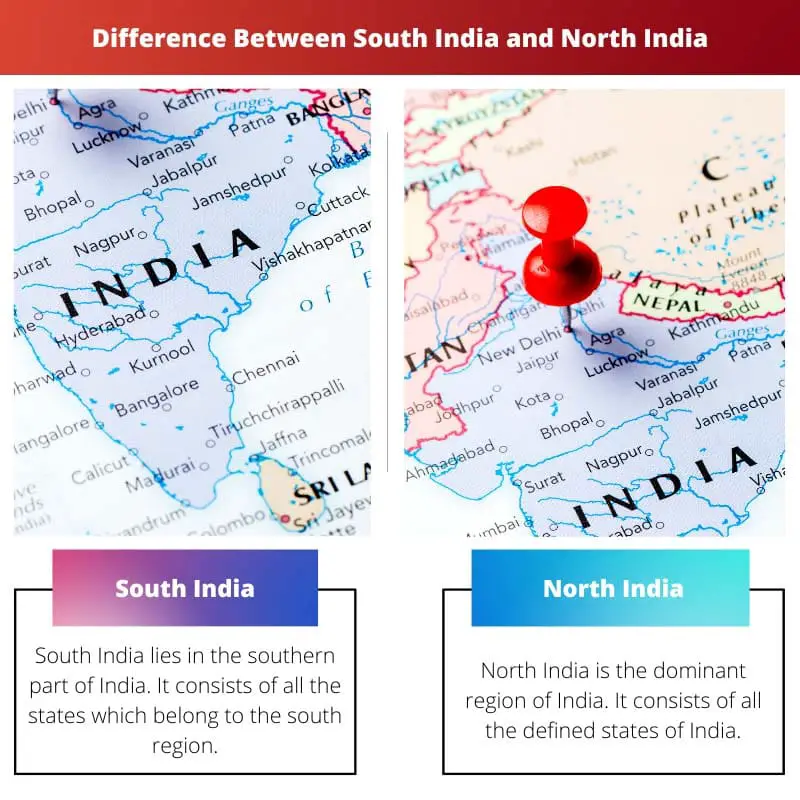There are different states in our country. Each state is divided into various territories. Our country is divided into four parts north, south, east, and west. North and south India has the majority number of states.
Both regions have a variety of cultures, languages, religions, and food tastes. There are a lot of differences between both areas.
Key Takeaways
- South India is known for its Dravidian languages, and North India for its Indo-Aryan languages.
- South Indian cuisine is rice-based, while North Indian cuisine is more wheat-based.
- South India has a tropical climate, while North India experiences more diverse climate conditions.
South India vs North India
South Indian cuisine is spicier than its northern counterpart, emphasizing rice-based dishes, while Northern Indian food is more dairy-heavy and wheat-based. The languages spoken in South India are Tamil, Telugu, Kannada, and Malayalam, while in North India, Hindi, Punjabi, Urdu, and Kashmiri.

South India lies in the southern part of India. It consists of all the states which belong to the south region. Kerala, Andhra, and Tamil Nadu come all under south India.
The culture and language of south India are dissimilar to north India. South India consists of 21 percent of India’s population.
North India is the dominant region of India. It consists of all the defined states of India. The Indus Gangetic plains and the Himalayas also lie in the northern part of India.
The customary language for every state in north India is Hindi. But, every state has its own language and style.
Comparison Table
| Parameters of Comparison | South India | North India |
|---|---|---|
| Climate | Tropical with the warmer environment. | Cool and dry in winters and hot in summer. |
| Landscape | North India is landlocked. | South India is surrounded by the Arabian sea. |
| Language | Tamil, Malayalam, and Kannada. | Hindi, Punjabi, and Urdu. |
| Food | Rice and lentils. | Staple food wheat and flatbreads. |
| Clothing | Sarees for women and dhoti for men. | Salwar for women and pants for men. |
What is South India?
South India is also known for its natural green beauty. The south region has different states with different varieties of food and culture. It also consists of two union territories of Lakshadweep and Puducherry.
South India is covered by the Arabian Sea in the west, the Bay of Bengal in the eastern part, and the Indian ocean in the southern region. 21 percent of the population lives in south India.
The majority of the people in the south speak four languages. Eastern ghats and western ghats are the two mountain regions in the south.
South India has a lot of water channels. Every state in the south region is blessed with one river flow. The Godavari, Krishna, Kaveri, Periyar rivers, and Bharathapuzha rivers are all connected through the states in south India.
English is a language that is used in the center and the state government in south India.
South India has tropical weather and climate. Most of the season is rainy. And it is hot in the summers. The languages spoken in south India were discovered 5000 years ago.
In south India, most of the people speak the Dravidian language. Rice and lentils are very famous among people. Food taste is very different in south India.

What is North India?
North India is a region with defined states in the northern part of India. The area is vastly dominated by the Himalayas and also Gangetic plains. North India is explained by various definitions and also it is defined by any governmental applications.
States in north India has a different role in different ministry affairs. The culture in north India is very different from south India. North India has been a center for various ancient empire regions.
It also has a historical past that is still present in some states. Some states have artifacts that belong to the old empire. There are a lot of monuments in north India which is now considered the tourist place for many tourists.
The languages spoken in north India are mostly Hindi, Urdu, Punjabi, and dongri. The weather in north India is cool and dry in winter. It has a severe hot and humid climate in summer.
North India has a monsoon season in June and mid-September. If you love spicy dishes then you should probably head to north India. North India is famous for spicy food.
The Currys are made of creamy layers with spice and also there are varieties of curries which are very famous.

Main Differences Between South India and North India
- The main difference between south India and north India is that south India has different languages like Dravidian. But north India has languages that have a connection to the early empires.
- Another difference is that south India has more monsoon seasons and a less humid climate. But north India has an equal amount of humidity and cold irrespective of the months.
- Another difference is that south India has different dance styles like Kathakali and Bharatanatyam. But north India has dance-like bhangra.
- Another difference is that south India is surrounded by the Arabian sea. But north India is surrounded by landscaped with different territorial boundaries.
- The other difference is that south India has a large spice exporting market. North India has a huge textile export market.

- https://academic.oup.com/ajcn/article-abstract/33/2/181/4692667
- https://www.tandfonline.com/doi/abs/10.1080/00324728.1983.10408866
